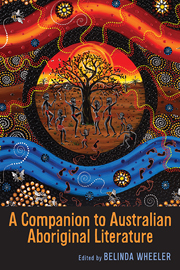Book contents
- Frontmatter
- Contents
- Foreword
- Acknowledgments
- Chronology
- Introduction: The Emerging Canon
- 1 Indigenous Life Writing: Rethinking Poetics and Practice
- 2 Australian Aboriginal Life Writers and Their Editors: Cross-Cultural Collaboration, Authorial Intention, and the Impact of Editorial Choices
- 3 Contemporary Life Writing: Inscribing Double Voice in Intergenerational Collaborative Life-Writing Projects
- 4 European Translations of Australian Aboriginal Texts
- 5 Tracing a Trajectory from Songpoetry to Contemporary Aboriginal Poetry
- 6 Rites/Rights/Writes of Passage: Identity Construction in Australian Aboriginal Young Adult Fiction
- 7 Humor in Contemporary Aboriginal Adult Fiction
- 8 White Shadows: The Gothic Tradition in Australian Aboriginal Literature
- 9 Bold, Black, and Brilliant: Aboriginal Australian Drama
- 10 The “Stolen Generations” in Feature Film: The Approach of Aboriginal Director Rachel Perkins and Others
- 11 A History of Popular Indigenous Music
- Notes on the Contributors
- Index
3 - Contemporary Life Writing: Inscribing Double Voice in Intergenerational Collaborative Life-Writing Projects
Published online by Cambridge University Press: 05 September 2013
- Frontmatter
- Contents
- Foreword
- Acknowledgments
- Chronology
- Introduction: The Emerging Canon
- 1 Indigenous Life Writing: Rethinking Poetics and Practice
- 2 Australian Aboriginal Life Writers and Their Editors: Cross-Cultural Collaboration, Authorial Intention, and the Impact of Editorial Choices
- 3 Contemporary Life Writing: Inscribing Double Voice in Intergenerational Collaborative Life-Writing Projects
- 4 European Translations of Australian Aboriginal Texts
- 5 Tracing a Trajectory from Songpoetry to Contemporary Aboriginal Poetry
- 6 Rites/Rights/Writes of Passage: Identity Construction in Australian Aboriginal Young Adult Fiction
- 7 Humor in Contemporary Aboriginal Adult Fiction
- 8 White Shadows: The Gothic Tradition in Australian Aboriginal Literature
- 9 Bold, Black, and Brilliant: Aboriginal Australian Drama
- 10 The “Stolen Generations” in Feature Film: The Approach of Aboriginal Director Rachel Perkins and Others
- 11 A History of Popular Indigenous Music
- Notes on the Contributors
- Index
Summary
The genre of Australian Indigenous life writing has, particularly in the 1990s, proliferated into a large critical field that, mirroring the quantity, popularity, and diversity of published life stories, examines various aspects of these narratives. One of these aspects is the nature of collaboration among participants, both Indigenous and non-Indigenous, in the process of eliciting, recording, writing, editing, and publishing such accounts. A number of scholarly studies have examined the complexities of this process and noted the long and notorious history of editorial intervention in the production of mostly orally transmitted life stories, an intervention that frequently led to some degree of misrepresenting Indigenous voices and cultural values (Jacklin, “Critical,” 56). From earlier “as-told-to” autobiographies to variously negotiated and complex collaborative oral history projects integrating multiple voices, the issues of power relations, authority, authenticity, representation, accommodation, and resistance come to the surface in any attempt to examine the mechanics of producing Indigenous life writing. One may wonder about the motives for paying such close attention to the ways in which Indigenous life stories are produced. Not surprisingly, this has to do with the genre itself: it has been widely acknowledged that Indigenous life writing has become an important vehicle for retrieving previously repressed histories of colonial violence, forced assimilation, and state intervention, and, therefore, it has been identified as a site of resistance (Brewster, Reading, 2–3; Nettlebeck, 43; Grossman, 174).
- Type
- Chapter
- Information
- A Companion to Australian Aboriginal Literature , pp. 53 - 70Publisher: Boydell & BrewerPrint publication year: 2013

